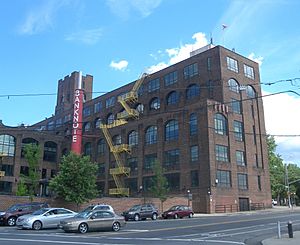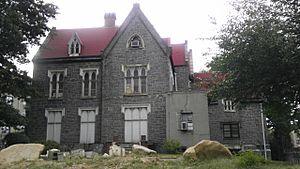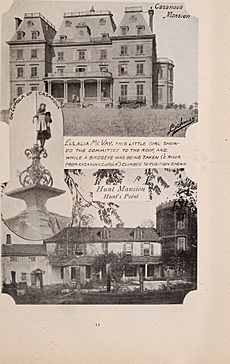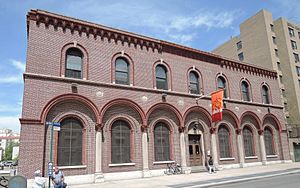Hunts Point, Bronx facts for kids
Quick facts for kids
Hunts Point
|
|
|---|---|
|
Neighborhood of the Bronx
|
|

The American Bank Note Company Printing Plant in Hunts Point
|
|
| Country | |
| State | |
| City | |
| Borough | |
| Community District | Bronx 2 |
| Founded | 1849 |
| Named for | Thomas Hunt |
| Area | |
| • Total | 4.27 km2 (1.650 sq mi) |
| Population
(2010)
|
|
| • Total | 12,281 |
| • Density | 2,873.8/km2 (7,443.0/sq mi) |
| Economics | |
| • Median income | $25,678 |
| Ethnicity | |
| • Hispanic | 74.6% |
| • Black | 22.2% |
| • White | 1.3% |
| • Asian | 0.7% |
| • Others | 1.2% |
| ZIP Codes |
10474
|
| Area code | 718, 347, 929, and 917 |
Hunts Point is a neighborhood located on a peninsula in the South Bronx of New York City. It is the location of one of the largest food distribution facilities in the world, the Hunts Point Cooperative Market. Its boundaries are the Bruckner Expressway to the west and north, the Bronx River to the east, and the East River to the south. Hunts Point Avenue is the primary street through Hunts Point.
The neighborhood is part of Bronx Community District 2, and its ZIP Code is 10474. The neighborhood is served by the New York City Police Department's 41st Precinct. NYCHA property in the area is patrolled by P.S.A. 7 at 737 Melrose Avenue located in the Melrose section of the Bronx.
Contents
History

Europeans first settled Hunts Point in 1663. At this time, Edward Jessup and John Richardson arrived on the peninsula and purchased the land from the Wekkguasegeeck tribe indigenous to the area. After Jessup died, his widow Elizabeth, entrusted the land to Thomas Hunt Jr., her son in-law for whom the area is named.
In the years between the Hunts' inheritance and 1850, several other wealthy landowning families occupied the peninsula. Legend has it that George Fox (1624–1691), founder of the Society of Friends (commonly known as Quakers), preached in the area in 1672. William H. Fox, a descendant of the Quaker leader, and his wife Charlotte Leggett, owned much of the land that is now Hunts Point.
As time passed and more New Yorkers became aware of Hunts Point, more City dwellers flocked to the area between 1850 and 1900. Later, the property wound up in the hands of Fox's and Leggett's son-in-law, H.D. Tiffany, a member of the family that owned the famous jewelry and decorative arts store Tiffany & Co. now on Fifth Avenue in Manhattan. Fox, Tiffany and Leggett Streets derive their names from these former landowners. In 1909, the Fox mansion was demolished.
Hunts Point’s status as a home and vacation spot to the city’s elite came to a rather abrupt end in the period following World War I. At this time, IRT Pelham Line was built along Southern Boulevard. Apartment buildings replaced mansions, streets replaced meadows and Hunts Point became a virtual melting pot for the City’s masses.
Aside from being a period of residential growth for Hunts Point, the 20th century has also been a time of industrial expansion for the peninsula. As more people moved to the area, the city’s business owners began to realize the advantages of locating to Hunts Point. Among them were the convenient access to the Tri-State region, the existing rail lines running through the Hunts Point area and the abundance of space available for the development of industrial and commercial activity.
This discovery led to an influx of businesses to the area. As the momentum of incoming businesses increased, the reputation of Hunts Point grew accordingly among business circles. With the openings of the New York City Produce market in 1967 and Hunts Point Meat Market in 1974, and culminating with the designation of Hunts Point as an In-Place-Industrial Park in 1980, Hunts Point has grown into a successful economic zone. The Hunts Point Industrial Park hosts over 800 businesses providing an array of products and services to points throughout the world.
The second half of the 20th century, however, proved a difficult time for the district's residential community. Characterized by frequent arson and mass abandonment from the 1960s through the 1990s, this period marked a low point in the area's history. Living conditions became so difficult that almost 60,000 residents, approximately two-thirds of the existing population, left the neighborhood during the 1970s. The first full-service post office did not open in the neighborhood until 2001.
Demographics
The Hunts Point peninsula has a population of 8,684. It is a low-income residential neighborhood largely made up of Puerto Ricans, with smaller numbers of African Americans, Dominicans, Mexicans, and other Latin Americans. Hunts Point has one of the highest concentrations of Hispanics in all of New York City. Almost half of the population lives below the federal poverty line.
Based on data from the 2010 United States Census, the population of Hunts Point and Longwood was 27,204, an increase of 2,062 (8.2%) from the 25,142 counted in 2000. Covering an area of 1,123.99 acres (454.86 ha), the neighborhood had a population density of 24.2 inhabitants per acre (15,500/sq mi; 6,000/km2).
The racial makeup of the neighborhood was 1.3% (342) White, 22.2% (6,049) African American, 0.2% (65) Native American, 0.7% (187) Asian, 0.0% (1) Pacific Islander, 0.2% (63) from other races, and 0.7% (192) from two or more races. Hispanic or Latino of any race were 74.6% (20,305) of the population.
The entirety of Community District 2, which comprises Hunts Point and Longwood, had 56,144 inhabitants as of NYC Health's 2018 Community Health Profile, with an average life expectancy of 78.9 years. This is lower than the median life expectancy of 81.2 for all New York City neighborhoods. Most inhabitants are youth and middle-aged adults: 28% are between the ages of between 0–17, 29% between 25–44, and 21% between 45–64. The ratio of college-aged and elderly residents was lower, at 12% and 10% respectively.
As of 2017, the median household income in Community Districts 1 and 2, including Melrose and Mott Haven, was $20,966. In 2018, an estimated 29% of Hunts Point and Longwood residents lived in poverty, compared to 25% in all of the Bronx and 20% in all of New York City. One in eight residents (12%) were unemployed, compared to 13% in the Bronx and 9% in New York City. Rent burden, or the percentage of residents who have difficulty paying their rent, is 58% in Hunts Point and Longwood, compared to the boroughwide and citywide rates of 58% and 51% respectively. Based on this calculation, as of 2018[update], Hunts Point and Longwood are gentrifying.
Land use and terrain
Hunts Point is a peninsula located at the confluence of the Bronx River and the East River, which is actually a tidal strait connecting Upper New York Bay to the Long Island Sound. The total land area is approximately 690 acres (2.8 km2).
Most of the land area in Hunts Point is dominated by industry. There is a small but dense residential pocket that occupies the high ground in the northern half of the peninsula along Hunts Point Avenue. It consists primarily of older apartment buildings with a smaller number of semi-detached multi-unit row houses. The area includes a recently developed park by the riverside, called the Hunts Point Riverside Park.
The New York City Department of City Planning designated a Special Hunts Point District in 2004 to incorporate zoning changes to encourage growth of the food distribution center while protecting the residential neighborhood.
Parks
Hunts Point Riverside Park was spearheaded by Majora Carter in 2000, and after several iterations, won the 2009 Rudy Bruner Award for Excellence in Public Spaces.
Joseph Rodman Drake Park is now recognized as an enslaved African-American burial ground
The largest park in Hunts Point is the 5-acre (20,000 m2) Barretto Point Park on the East River waterfront. It offers piers for fishing, sites for launching canoes and kayaks, and a floating swimming pool during the summer. There are also volleyball and basketball courts, a small amphitheater, and restroom facilities.
Hunts Point Food Distribution Center
Hunts Point is home to one of the largest food distribution centers in the world, covering 329 acres (1.33 km2). The Produce and Meat Distribution Center were opened along the Bronx river in 1967 and 1974, respectively. In 2005, Hunts Point became the site for New York City's New Fulton Fish Market, which replaced the 180-year-old fish market formerly located in downtown Manhattan. Over 800 industrial businesses, employing over 25,000 workers, are located on the peninsula. A large concentration of food wholesalers, distributors, and food processing businesses are located in the New York City zoned industrial business park. Below are some of the facilities that make up the Food Distribution Center in Hunts Point:
The New York City Terminal Market carries fresh fruit and vegetables from 49 states and 55 foreign countries. The market consists of four buildings, each one-third of a mile in length. More than 65 fruit and vegetable wholesalers own and operate the coop, which has 475,000 square feet (44,100 m2) of warehouse space. Each year approximately 2.7 billion pounds of produce are sold from the Market which as recently as 1998 posted $1.5 billion in revenues. The market caters to the largest ethnically diverse region in the world with an estimated population that exceeds 15 million people (New York metropolitan area).
The Hunts Point Cooperative Market handles the production, processing, distribution and sale of meat, poultry and related products. Spread over 38 acres (150,000 m2), the market’s six main buildings offer 700,000 square feet (70,000 m2) of refrigerated space. More than 50 independent wholesale food companies operate facilities here. In 2002, a state-of-the art, 100,000-square-foot (10,000 m2) refrigerated warehouse was added to accommodate the ever expanding needs businesses.
In November 2001, shortly before leaving office, former New York City Mayor Rudolph Giuliani broke ground for the new Fulton Fish Market building in Hunts Point. Nearly four years after the structure was completed, which cost $85 million to build, 55 businesses moved into a 450,000-square-foot (42,000 m2) complex, located within the Hunts Point Food Distribution Center. The facility generates an estimated $1 billion in yearly revenue, as it allows seafood distributors to store their goods in a temperature controlled warehouse with ease of access to NYC, New Jersey and Connecticut.
Detention centers
One secure detention center is located in Hunts Point.
Spofford Juvenile Center was formerly the New York City Department of Juvenile Justice's (DJJ) only Secure Detention center. The facility started as the Youth House for Boys and Youth House for Girls in the mid-1940s, and it moved to Hunts Point in 1957. The Youth House soon became known as Spofford Juvenile Center. On August 1, 1998, when it was vacated by the DJJ; earlier that year, on January 18, the city announced that the Horizon Juvenile Center, in the Mott Haven neighborhood of the Bronx, and the Crossroads Juvenile Center, in Brownsville, Brooklyn, would be opened to replace the Spofford facility. However, ultimately, Spofford was not closed, but was instead renamed Bridges Juvenile Center in 1999. In early 2011, Bridges was closed by the city. In announcing the closure, the Correctional Association of New York recognized that the facility had "a history of poor conditions and brutality against children."
The Vernon C. Bain Correctional Center (VCBC) is an 800-bed barge built on Rikers Island, for $161 million, currently used as part of the New York City Department of Corrections. It is designed to handle inmates from medium- to maximum-security in 16 dormitories and 100 cells. It was opened in 1992 and was named for Vernon C. Bain, a warden who died in a car accident. It has been used by the city of New York as a prison, but has also temporarily held juvenile inmates.
Public housing
There is one New York City Housing Authority low income housing development located in Hunts Point, Hunts Point Avenue Rehab, which includes thirteen rehabilitated tenement buildings, 4 and 5-stories tall.
Transportation
The following New York City Subway stations serve Hunts Point:
- Longwood Avenue (6 train)
- Hunts Point Avenue (6 <6> trains)
- Whitlock Avenue (6 train)
The following MTA Regional Bus Operations bus routes serve Hunts Point:
- Bx5 to Co-op City and Bay Plaza Shopping Center (via Bruckner Blvd and Story Avenue)
- Bx6 and Bx6 Select Bus Service to Washington Heights or Hunts Point Cooperative Market (via Hunts Point Avenue)
- Bx46 to Longwood or Hunts Point Cooperative Market (via Longwood Avenue and Tiffany Street)
Education
Hunts Point and Longwood generally have a lower rate of college-educated residents than the rest of the city as of 2018[update]. While 16% of residents age 25 and older have a college education or higher, 41% have less than a high school education and 43% are high school graduates or have some college education. By contrast, 26% of Bronx residents and 43% of city residents have a college education or higher. The percentage of Hunts Point and Longwood students excelling in math rose from 24% in 2000 to 26% in 2011, and reading achievement increased from 28% to 32% during the same time period.
Hunts Point and Longwood's rate of elementary school student absenteeism is more than the rest of New York City. In Hunts Point and Longwood, 35% of elementary school students missed twenty or more days per school year, higher than the citywide average of 20%. Additionally, 58% of high school students in Hunts Point and Longwood graduate on time, lower than the citywide average of 75%.
Schools
The Bronx Charter School for the Arts, the Bronx Lighthouse Charter School, Hyde Leadership Charter School, the South Bronx Classical Charter School, and UA Bronx Studio School for Writers and Artists are located in Hunts Point. In September 2011, Hyde Leadership Charter School opened on Hunts Point Avenue, the first college preparatory high school to open in Hunts Point in nearly 30 years.
Other schools include the John V. Lindsay Wildcat Academy Charter School, MS201 Theatre Arts & RSCH (As of 2008, it is now known as MS 424), P352 at 201 Vida Bogart School, PS 352, PS 48 Joseph R Drake, St. Ignatius School and Wildcat Second Opportunity School. IS 217, the School of Performing Arts, is also located in Hunts Point on Tiffany Street.
Library
The New York Public Library operates the Hunts Point branch at 877 Southern Boulevard. The Hunts Point library, a Carnegie library designed by Carrère and Hastings in the Italian Renaissance style, was opened in 1929. It was the last Carnegie library built for the New York Public Library system and is a New York City designated landmark.
Images for kids
-
Sunnyslope, a historic home located in Hunts Point










